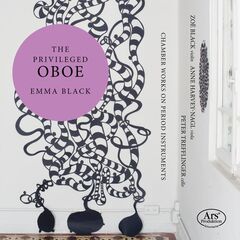Die australische Oboistin Emma Black, Solo-Oboistin bei der Wiener Akademie, Le Concert de la Loge sowie im Balthasar Neumann Ensemble und beim Australian Brandenburg Orchestra, unterrichtet am Institut für Alte Musik der Universität für Musik und darstellende Kunst Wien.
Auf diesem Album von Ars Produktion widmet sie sich der Gattung des Oboenquartetts und beginnt ihr Programm mit einem schwungvollen Quartett von Johann Christian Bach. Es folgt Mozarts virtuoses Oboenquartett KV 370, das in den schnellen Sätzen ganz besonders stilvoll elegant ist, während das Adagio mit sensibler Kantabilität exquisit klangschön vorgetragen wird. Diese Merkmale gelten auch für das Flötenquartett KV 285, das in dieser Aufnahme für die Oboe vom ursprünglichen D-Dur nach C-Dur versetzt wurde.
Eine sehr schöne Interpretation gibt es auch vom Oboenquartett op. 7/1 von Jean-Baptiste oder Jan Kritel Vanhal (1739-1813). Dieser Komponist, der ursprünglich aus Böhmen stammte, aber den größten Teil seines Lebens in Wien verbrachte, hat um die 100 Symphonien, 80 Quartette und zahlreiche andere Werke komponiert, darunter 30 Konzerte für verschiedene Soloinstrumente. Sein melodischer Sinn machte ihn zu einem der angenehmsten Komponisten der Wiener Klassik, doch Vanhals Kompositionen zeichnen sich auch durch eine bereits romantische Melancholie aus.
Der zweite Satz des Oboenquartetts ist ein schönes Beispiel für diesen melancholischen Zustand, und Emma Black und ihre Kollegen tun alles, um uns das mitzuteilen. Dasselbe ästhetische Streben in Kombination mit großer Sensibilität verleiht den schnellen Sätzen einen exquisiten Geschmack.
Australian oboist Emma Black, principal oboist of the Vienna Academy, Le Concert de la Loge, the Balthasar Neumann Ensemble and the Australian Brandenburg Orchestra, teaches at the Department of Early Music at the University of Music and Performing Arts Vienna.
On this Ars Produktion album, she dedicates herself to the oboe quartet genre, beginning her program with a lively quartet by Johann Christian Bach. This is followed by Mozart’s virtuoso Oboe Quartet KV 370, which is particularly stylish and elegant in the fast movements, while the Adagio is performed with exquisite beauty of sound and sensitive cantabile. These characteristics also apply to the Flute Quartet, K. 285, which has been transposed from the original key of D major to C major for the oboe.
There is also a very beautiful interpretation of the Oboe Quartet op. 7/1 by Jean-Baptiste or Jan Kritel Vanhal (1739-1813). This composer, who was originally from Bohemia but spent most of his life in Vienna, wrote about 100 symphonies, 80 quartets and numerous other works, including 30 concertos for various solo instruments. His melodic sense made him one of the most pleasing composers of the Viennese Classical period, but Vanhal’s compositions are also characterized by an already Romantic melancholy.
The second movement of the Oboe Quartet is a fine example of this melancholy state, and Emma Black and her colleagues do their best to convey it. The same aesthetic striving, combined with great sensitivity, gives the fast movements an exquisite flavor.


















